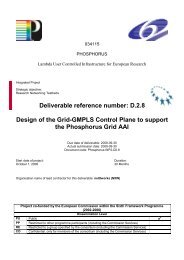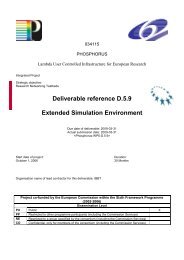Grid Job Routing Algorithms - Phosphorus
Grid Job Routing Algorithms - Phosphorus
Grid Job Routing Algorithms - Phosphorus
You also want an ePaper? Increase the reach of your titles
YUMPU automatically turns print PDFs into web optimized ePapers that Google loves.
<strong>Grid</strong> <strong>Job</strong> <strong>Routing</strong> <strong>Algorithms</strong>c4. ∑ λp, l i=sd∀i which is the first link in pcp PR l∈sdThe sum of all lightpaths departing from node s (source) to node d (destination) has to be equal to thecorresponding value R sd , of the traffic matrix.∑ λp l sd j which is the last link in pc, j= R ∀lcp P∈sdThe sum of all lightpaths originating from node s (source) to node d (destination) has to he equal to thecorresponding value R sd of the traffic matrix5.∑cλp, l− λp, l≤ 2Ti∀intermediate node i that has wavelengthij( i j )conversion capabilitie, where l , lsuccesive link s in p∈ p areFor nodes that have wavelength conversion capabilities, the number of lightpaths exiting in a differentwavelength from the one they were using when entering the node must not exceed twice the number of thewavelength converters available at the specific node. In essence, this constraint is equivalent toc c( λ,λ, )ij⎧⎫max ⎨∑±p l−p l ⎬2Ti⎩ c⎭As it has be shown, the total number of both optimization variables and the constraints of the formulation is onthe order of O(N 4 ), where N is the total number of nodes. This is the worst case; in practice, though, it is muchlower, since the topologies are seldom fully mesh, which is the assumption for O(N 4 ).Project:PHOSPHORUSDeliverable Number: D.5.3Date of Issue: 31/06/07EC Contract No.: 034115Document Code: <strong>Phosphorus</strong>-WP5-D5.398






